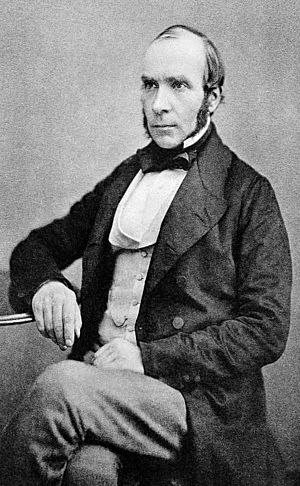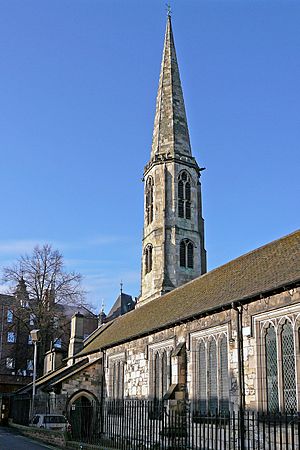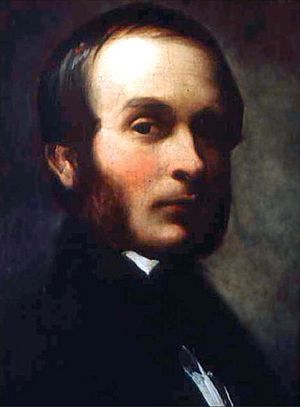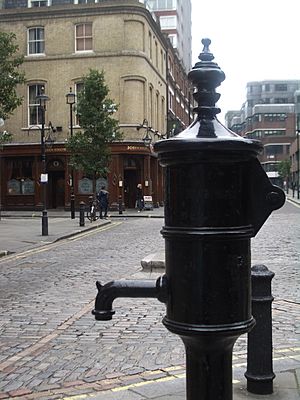John Snow facts for kids
Quick facts for kids
John Snow
|
|
|---|---|
 |
|
| Born | 15 March 1813 York, England
|
| Died | 16 June 1858 (aged 45) London, England
|
| Alma mater | University of London (MD) |
| Known for | Anaesthesia Locating source of a cholera outbreak (thus establishing the disease as water-borne) |
| Scientific career | |
| Fields | Anaesthesia Epidemiology |
| Signature | |
John Snow (born March 15, 1813 – died June 16, 1858) was an English doctor. He was a pioneer in developing anaesthesia and improving medical hygiene. Many consider him a founder of modern epidemiology, which is the study of how diseases spread.
Snow became famous for finding the source of a cholera outbreak in Soho, London, in 1854. He stopped the disease by removing the handle of a water pump. His discoveries helped make anaesthesia common. They also led to big changes in London's water and waste systems, which improved public health worldwide.
Contents
John Snow's Early Life and Education
John Snow was born on March 15, 1813, in York, England. He was the first of nine children. His father worked at a coal yard. The family lived in a poor area near the River Ouse, which often flooded.
Growing up, Snow saw a lot of dirty conditions in his hometown. Many streets were unclean, and the river was polluted by runoff from markets, cemeteries, and sewage. This experience likely influenced his later work on public health.

From a young age, Snow was very good at math. When he was 14, in 1827, he started training to be a doctor with William Hardcastle near Newcastle-upon-Tyne. In 1832, he saw his first cholera epidemic in a mining village called Killingworth. Snow treated many people who were sick, gaining valuable experience.
He decided to live a life of teetotalism, meaning he avoided alcohol. He also became a vegetarian and tried to drink only pure, distilled water. Between 1832 and 1835, Snow worked as an assistant to a doctor in coal-mining areas. In October 1836, he moved to London to study at the Hunterian school of medicine.
John Snow's Medical Career
In the 1830s, John Snow worked with surgeon Thomas Michael Greenhow at the Newcastle Infirmary. They both researched England's cholera outbreaks for many years.
In 1837, Snow began working at the Westminster Hospital. He became a member of the Royal College of Surgeons of England in 1838. He earned his medical degree (MD) from the University of London in 1844. In 1850, he joined the Royal College of Physicians.
Snow was a founding member of the Epidemiological Society of London, started in 1850. This group formed because of the cholera outbreak in 1849. By 1856, Snow and Dr. E.H. Greenhow were important members who discussed the "dreadful scourge" of cholera.
After finishing his studies, Snow opened his own practice in Soho, London. He worked as a surgeon and general doctor. John Snow contributed to many areas of medicine, including anaesthesiology. He was part of the Westminster Medical Society, where he shared his scientific ideas and research. He wrote and published articles, especially about breathing problems. In 1841, he wrote about his discoveries on how babies breathe and how body temperature affects them.
In 1857, Snow also wrote about how adding things to bread could cause rickets, a bone disease. This was an early step in studying how diet affects health.
How John Snow Developed Anaesthesia

John Snow's interest in anaesthesia and breathing started around 1841. By 1843, he was experimenting with ether to see its effects on breathing. Just one year after ether was first used in Britain, Snow published a guide on how to use it safely in 1847.
He also wrote many papers about his experiences with anaesthesia, noting reactions and procedures. Within two years, Snow became the most skilled anaesthetist in Britain. Top surgeons in London wanted his help.
Besides ether, John Snow also studied chloroform, which was introduced in 1847. He quickly realized that chloroform was much stronger and needed to be given with great care. He learned this after a 15-year-old patient named Hannah Greener died in 1848 during a small surgery. She had been given chloroform by covering her face with a cloth dipped in it.
After investigating her death and others, Snow realized that chloroform had to be given very carefully. He published his findings in a letter to The Lancet, a medical journal.
John Snow was one of the first doctors to figure out the right amounts of ether and chloroform to use for surgery. This allowed patients to have operations without pain. He designed special equipment to give ether safely and a mask for chloroform. His major book, On Chloroform and Other Anaesthetics and Their Action and Administration, was published after he died in 1858.
Even though he worked extensively with ether, he never tried to patent it. He simply continued his research and shared his discoveries.
John Snow and Pain Relief During Childbirth
Snow's work also greatly helped with pain relief during childbirth. He had a lot of experience with pregnant patients. He used different substances like ether, amylene, and chloroform. Chloroform was the easiest to use.
He treated 77 pregnant patients with chloroform. He would give the chloroform during the second stage of labor. He controlled the amount so patients were not completely asleep. They would only feel the first part of a contraction and be almost unconscious, but not fully. Snow believed it was safer if someone other than the surgeon gave the anaesthetic.
Many doctors and even the Church of England thought using chloroform for childbirth was wrong. However, on April 7, 1853, Queen Victoria asked John Snow to give her chloroform during the birth of her eighth child, Leopold. He did the same for her daughter Beatrice in 1857. This royal approval helped make pain relief during childbirth more accepted.
John Snow and the Cholera Outbreak
Snow did not believe in the popular idea called the miasma theory. This theory said that diseases like cholera were caused by "bad air" or pollution. The idea of germs had not yet been discovered, so Snow didn't know exactly how the disease spread. But his observations showed him that the "bad air" theory was wrong.
He first shared his own theory in an essay in 1849. He wrote a more detailed book in 1855, which included his research on the water supply's role in the 1854 Soho epidemic.
By talking to people living in the area, with help from Henry Whitehead, Snow found the source of the outbreak. It was a public water pump on Broad Street (now Broadwick Street). Even though his tests on the water didn't clearly prove it was dangerous, his studies of how the disease spread were convincing. He persuaded the local council to disable the pump by removing its handle.
Snow then used a dot map to show where the cholera cases were located around the pump. He also used statistics to show the link between water quality and cholera. He found that homes getting water from the Southwark and Vauxhall Waterworks Company, which took water from polluted parts of the Thames, had 14 times more cholera cases than those supplied by Lambeth Waterworks Company, which got cleaner water from upriver.
Snow's study was a huge step forward for public health and geography. It is seen as the beginning of the science of epidemiology.

Later, researchers found that the public well was only about 3 feet (1 meter) from an old cesspit, which had started leaking bacteria. A baby's dirty cloth, from a child who had cholera, had been washed into this cesspit. It was common then to have cesspits under homes.
John Snow's Personal Life
John Snow became a vegetarian at 17 and avoided alcohol. He ate vegetables, dairy products, and eggs. This diet helped him become an excellent swimmer. Later, he tried being a vegan.
In the mid-1840s, his health got worse, and he developed a kidney problem. He thought it was because of his vegan diet, so he started eating meat and drinking a little wine. He continued to drink pure (boiled) water throughout his life. He never married.
Snow lived at 18 Sackville Street, London, from 1852 until he died in 1858.
John Snow had a stroke while working in his London office on June 10, 1858. He was 45 years old. He died six days later, on June 16, 1858, and was buried in Brompton Cemetery.
Some people think his early death might have been linked to his frequent exposure to anaesthetic gases. These gases are now known to have harmful health effects. Snow worked with many different gases during his life, including ether and chloroform.
John Snow's Legacy and Honours

- A plaque marks the spot of the water pump on Broad Street (now Broadwick Street). It shows a water pump with its handle removed, remembering Snow's famous act.
- A pub nearby is named "The John Snow" in his honor.
- The John Snow Society is named after him and often meets at The John Snow pub. They hold an annual lecture about public health.
- His grave in Brompton Cemetery, London, has a special monument.
- In York, a blue plaque on the Park Inn hotel remembers John Snow.
- John Snow is one of the heraldic supporters for the Royal College of Anaesthetists, alongside another anaesthesia pioneer, Joseph Thomas Clover.
- The Association of Anaesthetists of Great Britain and Ireland gives out The John Snow Award to medical students researching anaesthesia.
- In 1978, a public health research company called John Snow, Inc was founded.
- In 2001, the John Snow College was opened at the University of Durham.
- In 2009, the John Snow lecture theatre was opened at the London School of Hygiene & Tropical Medicine.
- In 2013, The Lancet medical journal corrected its original short obituary of Snow from 1858. They admitted they had not fully recognized his amazing work in epidemiology and understanding how cholera spread.
- In 2017, a memorial pump with its handle removed was put up in York, near his birthplace.
- The 2019 TV series Victoria showed John Snow meeting Queen Victoria. In the show, with the Queen's help, he gets the Broad Street pump handle removed.
See also
 In Spanish: John Snow para niños
In Spanish: John Snow para niños
- Joseph Bazalgette, a famous sewer engineer for London.




